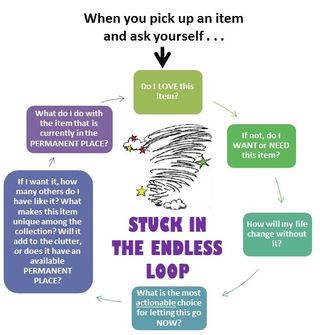Health
Begin Decluttering by Setting Realistic Expectations
What to do when you don't know where to start.
Posted March 4, 2020 Reviewed by Ekua Hagan
We encourage clients not to turn de-cluttering tasks into a drudgery. Unless your situation is an imminent health or safety hazard for yourself or others, it truly is the manageable work periods you carry out every single day that will get you to where you need to be and keep you there.
To start, we recommend one 15-minute period of de-cluttering every day and only if you feel energised by it. Then add only 15 more minutes of de-cluttering.
However, we also ask you to make a commitment to yourself that if you start that second 15-minute work period, you must complete the full 15 minutes. The rationale for this is described in our last post.
This is a very manageable method of developing the skill of self-regulation, which makes life easier and more effective. Remember, if you make the task a drudge, you will not return to it regularly and consistently enough to reach the success you want.
Now, let’s consider two questions.
What causes the accumulation to be maintained?
Something prompted your original plan to be changed. Your reasons for the change in the plan might be entirely understandable but the clutter is still being maintained. How and why?
What stops you from resolving the accumulation?
As you look at this space, the next question to ask is, “What keeps me from resolving this situation?” Do your thoughts, fears, beliefs, or lifestyle prevent you from resolving the situation? Are you so overwhelmed by your clutter that you cannot move forward to how you want to live? Do you find making decisions more difficult than you can manage right now? These factors, positive and negative, must be factored into our new strategy.
Be who you are unapologetically but honestly. That is the best way to develop a realistic plan—by setting SMART goals and then reaching them.
We encourage goals that:
- Respect the attachment you feel but set limits guided by space and time.
- Respect the relationship you have with your things; i.e., the memories, alternative uses, personal aesthetic attraction and therefore your needs and preferences.
- Work at your pace.
- Challenge you to be aware of what you actually see when you look at an item that might be different from the norm.
- Challenge you to ask what you feel and what you say to yourself when you look at items.
- Help you be aware of and appreciate what your relationship is to each item and the complications you feel that influence your need for it.
Learn from the past and determine how the accumulation started.
Imagine we are sitting with you now. Choose a space to look at first and consider:
What is the accumulation made up of?
What was the plan when you placed these items where they are?
Were there beliefs, needs, or a vision behind that plan?
Given the buildup, were there events or competing choices which prompted you to alter the plan?
Did you begin to lose focus on the plan? If so, when and why?
Did something disruptive happen during the timeframe when the buildup began?
Did you start to put the plan in place and encounter barriers?
If so, what were/are those barriers and are they still present?
When you look at the piles, do you see a collection of items (for example, documents, unopened mail, bills, and receipts) with common dates? Are these dates associated with anything that happened at that time?
Was there some other reason that prompted you to change or abandon your plan?
Do you start multiple things and not finish them?
Do you have difficulty deciding on assigning permanent places for things? If so, try this strategy.
As a first step, can you decide where these things normally are used?
Decide the permanent place for each keep item.
This technique is very helpful to decide where things should be kept. I credit my lead clutter coach, Heather Wolfer, for this strategy. Thank you, Heather!
Hold or touch each item, then close your eyes and ask, “If I were looking for you, where would I look first?” Trust yourself. The answer is its permanent place because that is always where you naturally will look first. If the item is irreversibly contaminated or damaged, let’s have a different conversation before deciding on a permanent place.
Otherwise, the permanent place for an item is better if it follows the following guidelines:
- The item’s permanent place needs to be a dedicated spot where or as close to where it is normally used.
- The permanent place must keep the item so that it remains accessible.

When it is difficult to determine the desired permanent place, try the following:
As long as you are not creating a health or safety hazard, take each thing and, even if you can’t put it where you have decided its permanent place is, put it as close to that spot as you can. It may feel like you are just moving piles, but if you are not creating a health or safety hazard, you’ll deal with it when you get to that area.
You’re almost there! Practice these strategies to prepare for our sorting process, which we will cover in the next post.




